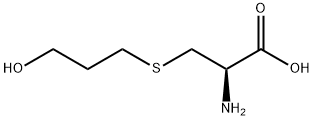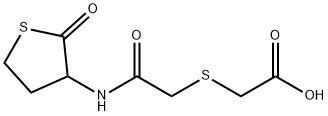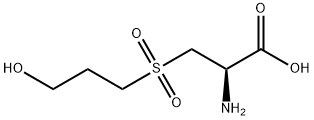Fudosteine , 10mMinWater , 13189-98-5
CAS NO.:13189-98-5
Empirical Formula: C6H13NO3S
Molecular Weight: 179.24
MDL number: MFCD00899873
EINECS: 1592732-453-0
| Pack Size | Price | Stock | Quantity |
| 1ml | RMB159.20 | In Stock |
|
| others | Enquire |
PRODUCT Properties
| Melting point: | 200-202°C (dec.) |
| Boiling point: | 354.5±42.0 °C(Predicted) |
| Density | 1.301±0.06 g/cm3(Predicted) |
| storage temp. | Keep in dark place,Inert atmosphere,Store in freezer, under -20°C |
| solubility | Water (Slightly) |
| form | Solid |
| pka | 2.09±0.10(Predicted) |
| color | White to Light Brown |
| CAS DataBase Reference | 13189-98-5(CAS DataBase Reference) |
Description and Uses
Fudostein was launched in Japan as a new mucoactive agent for the treatment of bronchitis and respiratory congestion. This cysteine derivative was obtained from L-cysteine by condensation with either allylic alcohol in the presence of potassium persulfate or the corresponding bromoalcohol in the presence of a base. Fudostein was shown to significantly reduce mucus glycoprotein hypersecretion and inhibit infiltration of airway mucosa by lymphocytes and inflammatory cells in bronchitic rats. When given to bronchitic rabbits, an oral dose of 500 mg/kg daily potently decreased the fucose/ N-acetylneuraminic acid in sputa, so exhibiting mucoregulatory properties. In another study with SO2-exposed rabbits, fudostein suppressed blood flow of tracheal microvasculature increased by SO2, partly due to scavenging of superoxide anion.
Fudosteine is a cysteine derivative that interferes with the increase in goblet cell number, expression of the mucin MUC5AC, and subsequent mucin secretion, in airways agonized with tobacco smoke, isoproterenol, lipopolysaccharide, TNF-α, or oxidants. Fudosteine, which is a thiol compound with antioxidant properties, limits NF-κB signaling and reduces inflammatory gene expression. It has greater bioavailability than N-acetyl-cysteine and increases cysteine levels in cells.
Safety
| Symbol(GHS) |  GHS07 |
| Signal word | Warning |




![L-ALANINE, 3-[(3-HYDROXYPROPYL)SULFINYL]-](https://img.chemicalbook.com/CAS/GIF/209665-22-5.gif)

